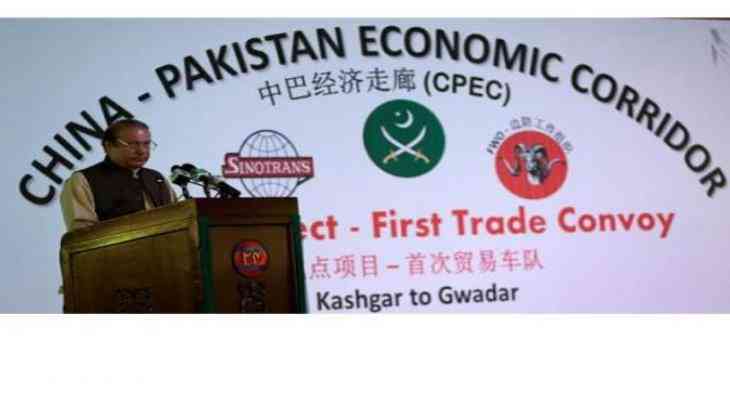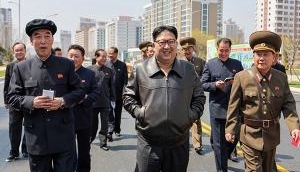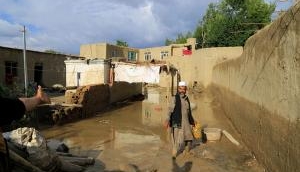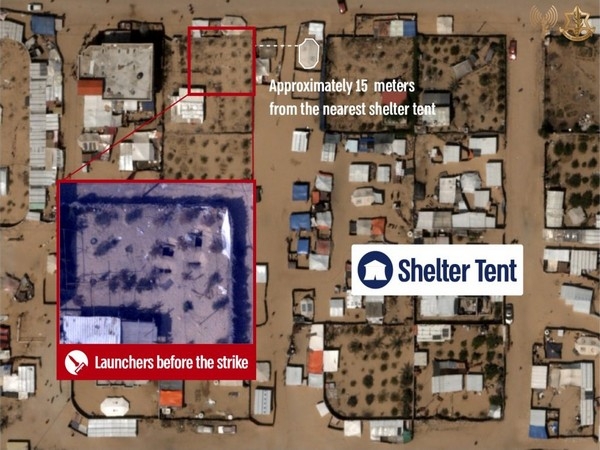
A detailed master plan for the China Pakistan Economic Corridor (CPEC) stretching out till 2030 has been revealed by Pakistan daily Dawn. The plan reportedly details China's intentions and priorities in Pakistan for the next decade and a half.
According to the daily, the Pakistan Government has two versions of the long term plan. It is 231-pages long and has been drawn up by the China Development Bank (CDB) and the National Development Reform Commission (NDRC).
Following are some of the highlights of the plan:
. Thousands of acres of agricultural land will be leased out to Chinese enterprises to set up "demonstration projects" in areas ranging from seed varieties to irrigation technology.
. A full system of monitoring and surveillance will be built in cities from Peshawar to Karachi, with 24 hour video recordings on roads and busy marketplaces for law and order.
. A national fibre-optic backbone will be built for the country not only for internet traffic, but also for terrestrial distribution of broadcast TV, which will cooperate with Chinese media in the "dissimenation of Chinese culture".
. At the outset, the CPEC will connect the Xinjiang Uygur Autonomous Region (XUAR) and Pakistan.
. The main aim is to connect South Xinjiang with Pakistan. This region will be divided into a "core area" and what the Chinese call "radiation zones", those territories that will feel the knock on effects of the work being done in the core area.
. The core area includes Kashgar, Tumshuq, Atushi and Akto of Kizilsu Kirghiz of Xinjiang from China, most of Islamabad's Capital Territory, Punjab, and Sindh, some areas of Gilgit-Baltistan, Khyber Pukhtunkhwa, and Balochistan from Pakistan.
. The CPEC will include one belt, three passages, and two axes and five functional zones. The belt will be the strip area formed by important arterial traffic in China and Pakistan.
. The plan envisages a deep and broad-based penetration of most sectors of Pakistan's economy and society by Chinese enterprises and culture.
. In some areas the plan seeks to build on a market presence already established by Chinese enterprises, as for example Haier in household appliances, ChinaMobile and Huawei in telecommunications and China Metallurgical Group Corporation (MCC) in mining and minerals.
. Punjab is only provincial government that has received the full version of the plan.
. A key element in this is the creation of industrial parks, or special economic zones, which must meet specified conditions, including availability of water, perfect infrastructure, sufficient supply of energy and the capacity of self service power.
. The plan's main thrust lies in agriculture, rather than on industrial or transport undertaking.
There is also, according to the Dawn, a shortened version of the plan dated February 2017.
Its highlights are as follows:
. It contains only broad brushstroke descriptions of the various "areas of cooperation" and no details.
. It was drawn up for circulation to the provincial governments to obtain their assent.
. It is 30 pages long.
Agriculture highlights:
. Provisioning for seeds and other inputs, like fertilizer, credit, and pesticides.
. Chinese enterprises to operate their own farms, processing facilities for fruits and vegetables and grain.
. Logistics companies will operate a large storage and transportation system for agrarian produce.
. Identify opportunities for entry of Chinese enterprises in myriad dysfunctions that afflict Pakistan's agriculture sector.
. Enterprises entering agriculture will be offered extraordinary levels of assistance by Beijing.
. The plan also offers to maintain a mechanism to help Chinese agricultural enterprises contact representatives of the Governments of Pakistan and China.
. China will actively strive to utilize national special funds as the discount interest for the loans of agricultural foreign investment.
. For the long term, financial risk will be spread out through new types of financing such as consortium loans, joint private equity and joint debt issuance, raise funds via multiple channels and decentralise financing risks.
. To harness the work of the Xinjiang Production and Construction Corps to bring mechanization as well as scientific technique in livestock breeding, development of hybrid varieties and precision irrigation to Pakistan.
. To help develop Kashgar Prefecture, which suffers from a poverty incidence of 50 per cent, and has no connect to larger markets. The prefecture's total output in agriculture, forestry, animal husbandry and fishery amounted to just over USD 5 billion in 2012, and its population was less than four million in 2010, hardly a market with windfall gains for Pakistan.
. The plan makes some reference to export of agriculture goods from ports, but the bulk of its emphasis is focused on the opportunities for the Kashgar Prefecture and Xinjiang Production Corps.
Highlights of opportunities for profitable engagement in Pakistan's domestic market:
. Identifies 10 key areas for engagement along with seventeen specific projects, including construction of one NPK fertilizer plant with an annual output of 800,000 tons.
. Enterprises will be inducted to lease farm implements, like tractors, efficient plant protection machinery, efficient energy saving pump equipment, precision fertilization drip irrigation equipment and planting and harvesting machinery.
. The plan shows great interest in the textiles industry and is particularly focused on yarn and coarse cloth.
. Meat processing plants in Sukkur are planned with annual output of 200,000 tons per year, and two demonstration plants processing 200,000 tons of milk per year.
. In crops, demonstration projects of more than 6,500 acres will be set up for high yield seeds and irrigation, mostly in Punjab.
Transport and Storage highlights:
. To build a nation-wide logistics network and enlarge the warehousing and distribution network between major cities of Pakistan with a focus on grains, vegetables and fruits.
. Storage bases will be built first in Islamabad and Gwadar in the first phase, then Karachi, Lahore and another in Gwadar in the second phase.
. Between 2026-2030, Karachi, Lahore and Peshawar will each see another storage base.
. Asadabad, Islamabad, Lahore and Gwadar will see a vegetable processing plant, with annual output of 20,000 tons, fruit juice and jam plant of 10,000 tons and grain processing of one million tons.
. A cotton processing plant is also planned initially, with output of 100,000 tons per year.
.To build a three-level warehousing system (purchase and storage warehouse, transit warehouse and port warehouse).
. The plan speaks of a long belt of coastal enjoyment industry that includes yacht wharfs, cruise homeports, nightlife, city parks, public squares, theaters, golf courses and spas, hot spring hotels and water sports.
Trade highlights:
. To cultivate surrounding countries in order to improve import and export potential of Pakistani agricultural products and accelerate trade of agricultural products.
. The plan says Chinese enterprises should seek coordinated cooperation with Pakistani enterprises and maintain orderly competition and mutual coordination.
. Enterprises will be advised to respect the religions and customs of the local people, treat people as equals and live in harmony. They will also be advised to increase local employment and contribute to local society by means of subcontracting and consortiums.
. China will strengthen safety cooperation with key countries, regions and international organizations, jointly prevent and crack down on terrorist acts that endanger the safety of Chinese overseas enterprises and their staff.
Industry highlights:
. The plan trifurcates the country into three zones: western and northwestern, central and southern. Each zone is marked to receive specific industries in designated industrial parks. The western and northwestern zone, covering most of Balochistan and Khyber Pakhtukhwa province, is marked for mineral extraction, with potential in chrome ore, "gold reserves hold a considerable potential, but are still at the exploration stage", and diamonds.
. The plan looks to set up 12 marble and granite processing sites in locations ranging from Gilgit and Kohistan in the north, to Khuzdar in the south.
. Plan to build a pilot safe city in Peshawar.
. Central zone is marked for textiles, household appliances and cement. Locations for future cement clusters include Daudkhel, Khushab, Esakhel and Mianwali.
. China likely to take investment advantage of Pakistan's surplus in cement.
. The southern zone will focus on developing petrochemical, iron and steel, harbor industry, engineering machinery, trade processing and auto and auto parts (assembly)" due to the proximity of Karachi and its ports.
. Focus will also be on the auto industry, one of the fastest growing in Pakistan.
. The plan recommends that Gwadar be built into a base of heavy and chemical industries, such as iron and steel/petrochemical.
. Preferential policies will be necessary to attract enterprises to come to the newly built industrial parks envisioned under the plan.
. Priority to be given to fibre-optic connectivity between China and Pakistan. An MoU for such a link was signed in July 2013. The plan reveals that the link goes far beyond a simple fibre-optic set up. The plan envisages a terrestrial cable across the Khunjerab pass to Islamabad, and a submarine landing station in Gwadar, linked to Sukkur. From there, the backbone will link the two in Islamabad, as well as all major cities in Pakistan. The expanded bandwidth is expected to open up will enable terrestrial broadcast of digital HD television, called Digital Television Terrestrial Multimedia Broadcasting (DTMB).
. The plan says nothing about how the system will be used to control the content of broadcast media, nor does it say anything more about the future cooperation between Chinese and Pakistani media.
.Pakistan is pushing the China to begin work on the Gwadar International Airport, while the latter is pushing for early completion of the Eastbay Expressway.
. The plan also seeks to create an electronic monitoring and control system for the border in Khunjerab, as well as run a "safe cities" project.
Tourism and recreation highlights:
. A long belt of coastal enjoyment industry from Keti Bunder to Jiwani, the last habitation before the Iranian border.
-ANI







![BJP's Kapil Mishra recreates Shankar Mahadevan’s ‘Breathless’ song to highlight Delhi pollution [WATCH] BJP's Kapil Mishra recreates Shankar Mahadevan’s ‘Breathless’ song to highlight Delhi pollution [WATCH]](http://images.catchnews.com/upload/2022/11/03/kapil-mishra_240884_300x172.png)

![Anupam Kher shares pictures of his toned body on 67th birthday [MUST SEE] Anupam Kher shares pictures of his toned body on 67th birthday [MUST SEE]](http://images.catchnews.com/upload/2022/03/07/Anupam_kher_231145_300x172.jpg)


_251371_1280x720.jpg)



